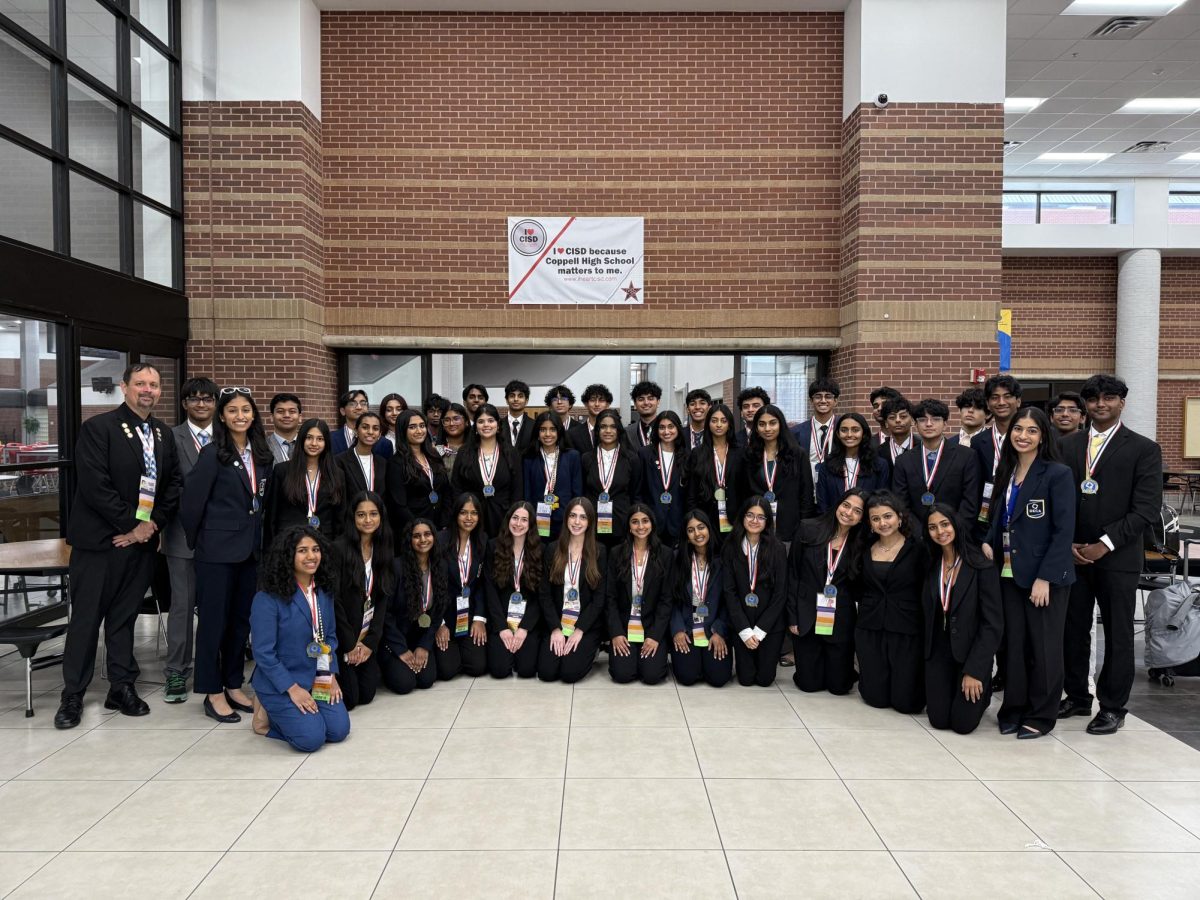
by Divya Kumar
News Editor
Video by Brian O’Connor
While most of the products that the Coppell Engineering team produces require intense knowledge in mathmatical and scienficic areas, none are quite so challenging as the Winston Solar Car competition.
This competition, designed for high school engineering students, focuses on the creation of a car that will be drivable solely off of a battery charged by solar power. Though such a task seems beyond the means of an average student, the CHS Solar Car team proves otherwise.
Beginning last July, the team has been meeting to work and design the basic elements for their car. A combination of 15 students, ranging from sophomores to seniors, meets twice a week after school on Mondays and Thursdays in Engineering teacher and JETS club sponsor Mike Yakubovsky’s room to work on the construction of the car.
“Efficiency is really our primary concern,” Yakubovsky said. “We’ve been working on a viable model of a frame to put in place for a while. Last year the suspension of our car gave way, which is a big factor in the race, so we’re using those experiences to build off on what we should do this year and how to design the car accordingly.”
The car is built for one person to drive, with six solar panels lining the top. The team spent a good deal of time on design for the car, making sure the suspension – or the part of the car that attaches it firmly to the wheels – was all in line. Upon the completion of this, the car will be covered and four wheels attached.
Though Yakkubovsky is there to advise and assist, it remains mainly a student-based organization. All parts were ordered online, and heavy advertising was enforced around Coppell through means of a team poster, sponsoring, a booster club, newsletter and podcast, enough money was raised by the students to budget the project, and bring it towards an end.
“We’ve been working on this forever,” Project Manager junior Meera Patel said. “This car has been our focus for over a year. It’s hard to imagine it’s almost done, just because of the amount of time it’s been in the process of being made – whether it be the advertising, buying parts or actually just building the car.”
Within the next week, the car should be drivable, and will be tested on roads around Coppell. A scrutineering session is set to be held on July 16 at Texas Motor Speedway, where competition officials will check over the car to make sure that it follows regulations and is fit to drive.
Then, beginning on July 18, an eight day cross-country race will be taken by the team. Starting in Dallas and ending in Colorado, the race will be comprised of a series of distances that need to be driven. The team is to record how far the solar car was able to drive during each series without stopping to be recharged or towed away.
In order to maintain safety, the one-driver car will be surrounded on both sides by driving cars and a trailer in front and back. Since these cars will be traveling on highways alongside other normal ones, it is vital that they remain protected from any possible accidents.
“The people driving will be the smallest and lightest on the team, to conserve the battery power,” Patel said. “That narrows it down to three of us who will actually be driving the race.”
Despite the fact that all three of the assigned team drivers – Patel, Brinegar and senior Rishi Samani – hold valid drivers licenses, their past experiences on the road don’t seem applicable to the same challenge.
“It’s a little frightening to be driving in a car that you’ve build yourself,” Brinegar said. “But luckily there are enough cars surrounding us, so the danger is rather minimal.”
In addition to similar anxiety about performing in an unknown situation, Patel expresses excitement over the opportunity of such a rare experience.
“It’s really the only advantage I’ve ever had to being short,” she said.
After each day of racing is complete, the solar panels will be removed from the top of the car and laid outside in order to recharge and gain as much sunlight as possible. The team’s battery box, however, must remain locked in order to ensure that it cannot be tampered with during the race.
“The essence of the race is us driving for three hours, stopping for a ‘media break’ where we advertise the challenge and solar energy possibilities, and then heading back on the road till we’ve hit our mark for the day,” Yakubovsky said. “The car should be able to average about 30 to 35 miles per hour if all goes according to plan.”
As the finishing touches are being put on the car, tensions and excitement over the upcoming summertime competition raise.
“Honestly, there’s a lot of talk about trying to find alternative fuel sources for cars generating,” Patel said. “And though this project is mainly for fun, it’s also made me realize the real-world implications behind it, and how through this, we’re getting one step closer to a major breakthrough. It’s just the coolest thing I’ve ever done in school.”








